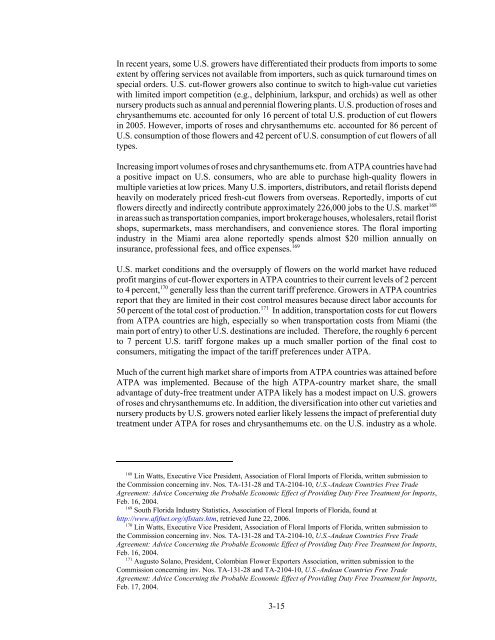The Impact of the Andean Trade Preference Act Twelfth ... - USITC
The Impact of the Andean Trade Preference Act Twelfth ... - USITC
The Impact of the Andean Trade Preference Act Twelfth ... - USITC
- No tags were found...
Create successful ePaper yourself
Turn your PDF publications into a flip-book with our unique Google optimized e-Paper software.
In recent years, some U.S. growers have differentiated <strong>the</strong>ir products from imports to someextent by <strong>of</strong>fering services not available from importers, such as quick turnaround times onspecial orders. U.S. cut-flower growers also continue to switch to high-value cut varietieswith limited import competition (e.g., delphinium, larkspur, and orchids) as well as o<strong>the</strong>rnursery products such as annual and perennial flowering plants. U.S. production <strong>of</strong> roses andchrysan<strong>the</strong>mums etc. accounted for only 16 percent <strong>of</strong> total U.S. production <strong>of</strong> cut flowersin 2005. However, imports <strong>of</strong> roses and chrysan<strong>the</strong>mums etc. accounted for 86 percent <strong>of</strong>U.S. consumption <strong>of</strong> those flowers and 42 percent <strong>of</strong> U.S. consumption <strong>of</strong> cut flowers <strong>of</strong> alltypes.Increasing import volumes <strong>of</strong> roses and chrysan<strong>the</strong>mums etc. from ATPA countries have hada positive impact on U.S. consumers, who are able to purchase high-quality flowers inmultiple varieties at low prices. Many U.S. importers, distributors, and retail florists dependheavily on moderately priced fresh-cut flowers from overseas. Reportedly, imports <strong>of</strong> cutflowers directly and indirectly contribute approximately 226,000 jobs to <strong>the</strong> U.S. market 168in areas such as transportation companies, import brokerage houses, wholesalers, retail floristshops, supermarkets, mass merchandisers, and convenience stores. <strong>The</strong> floral importingindustry in <strong>the</strong> Miami area alone reportedly spends almost $20 million annually oninsurance, pr<strong>of</strong>essional fees, and <strong>of</strong>fice expenses. 169U.S. market conditions and <strong>the</strong> oversupply <strong>of</strong> flowers on <strong>the</strong> world market have reducedpr<strong>of</strong>it margins <strong>of</strong> cut-flower exporters in ATPA countries to <strong>the</strong>ir current levels <strong>of</strong> 2 percentto 4 percent, 170 generally less than <strong>the</strong> current tariff preference. Growers in ATPA countriesreport that <strong>the</strong>y are limited in <strong>the</strong>ir cost control measures because direct labor accounts for50 percent <strong>of</strong> <strong>the</strong> total cost <strong>of</strong> production. 171 In addition, transportation costs for cut flowersfrom ATPA countries are high, especially so when transportation costs from Miami (<strong>the</strong>main port <strong>of</strong> entry) to o<strong>the</strong>r U.S. destinations are included. <strong>The</strong>refore, <strong>the</strong> roughly 6 percentto 7 percent U.S. tariff forgone makes up a much smaller portion <strong>of</strong> <strong>the</strong> final cost toconsumers, mitigating <strong>the</strong> impact <strong>of</strong> <strong>the</strong> tariff preferences under ATPA.Much <strong>of</strong> <strong>the</strong> current high market share <strong>of</strong> imports from ATPA countries was attained beforeATPA was implemented. Because <strong>of</strong> <strong>the</strong> high ATPA-country market share, <strong>the</strong> smalladvantage <strong>of</strong> duty-free treatment under ATPA likely has a modest impact on U.S. growers<strong>of</strong> roses and chrysan<strong>the</strong>mums etc. In addition, <strong>the</strong> diversification into o<strong>the</strong>r cut varieties andnursery products by U.S. growers noted earlier likely lessens <strong>the</strong> impact <strong>of</strong> preferential dutytreatment under ATPA for roses and chrysan<strong>the</strong>mums etc. on <strong>the</strong> U.S. industry as a whole.168 Lin Watts, Executive Vice President, Association <strong>of</strong> Floral Imports <strong>of</strong> Florida, written submission to<strong>the</strong> Commission concerning inv. Nos. TA-131-28 and TA-2104-10, U.S.-<strong>Andean</strong> Countries Free <strong>Trade</strong>Agreement: Advice Concerning <strong>the</strong> Probable Economic Effect <strong>of</strong> Providing Duty Free Treatment for Imports,Feb. 16, 2004.169 South Florida Industry Statistics, Association <strong>of</strong> Floral Imports <strong>of</strong> Florida, found athttp://www.afifnet.org/sflstats.htm, retrieved June 22, 2006.170 Lin Watts, Executive Vice President, Association <strong>of</strong> Floral Imports <strong>of</strong> Florida, written submission to<strong>the</strong> Commission concerning inv. Nos. TA-131-28 and TA-2104-10, U.S.-<strong>Andean</strong> Countries Free <strong>Trade</strong>Agreement: Advice Concerning <strong>the</strong> Probable Economic Effect <strong>of</strong> Providing Duty Free Treatment for Imports,Feb. 16, 2004.171Augusto Solano, President, Colombian Flower Exporters Association, written submission to <strong>the</strong>Commission concerning inv. Nos. TA-131-28 and TA-2104-10, U.S.-<strong>Andean</strong> Countries Free <strong>Trade</strong>Agreement: Advice Concerning <strong>the</strong> Probable Economic Effect <strong>of</strong> Providing Duty Free Treatment for Imports,Feb. 17, 2004.3-15
















